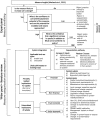Characterising the biophysical, economic and social impacts of soil carbon sequestration as a greenhouse gas removal technology
- PMID: 31532049
- PMCID: PMC7079085
- DOI: 10.1111/gcb.14844
Characterising the biophysical, economic and social impacts of soil carbon sequestration as a greenhouse gas removal technology
Abstract
To limit warming to well below 2°C, most scenario projections rely on greenhouse gas removal technologies (GGRTs); one such GGRT uses soil carbon sequestration (SCS) in agricultural land. In addition to their role in mitigating climate change, SCS practices play a role in delivering agroecosystem resilience, climate change adaptability and food security. Environmental heterogeneity and differences in agricultural practices challenge the practical implementation of SCS, and our analysis addresses the associated knowledge gap. Previous assessments have focused on global potentials, but there is a need among policymakers to operationalise SCS. Here, we assess a range of practices already proposed to deliver SCS, and distil these into a subset of specific measures. We provide a multidisciplinary summary of the barriers and potential incentives towards practical implementation of these measures. First, we identify specific practices with potential for both a positive impact on SCS at farm level and an uptake rate compatible with global impact. These focus on: (a) optimising crop primary productivity (e.g. nutrient optimisation, pH management, irrigation); (b) reducing soil disturbance and managing soil physical properties (e.g. improved rotations, minimum till); (c) minimising deliberate removal of C or lateral transport via erosion processes (e.g. support measures, bare fallow reduction); (d) addition of C produced outside the system (e.g. organic manure amendments, biochar addition); (e) provision of additional C inputs within the cropping system (e.g. agroforestry, cover cropping). We then consider economic and non-cost barriers and incentives for land managers implementing these measures, along with the potential externalised impacts of implementation. This offers a framework and reference point for holistic assessment of the impacts of SCS. Finally, we summarise and discuss the ability of extant scientific approaches to quantify the technical potential and externalities of SCS measures, and the barriers and incentives to their implementation in global agricultural systems.
Keywords: 4 per mille; agriculture; greenhouse gas removal; negative emissions; soil carbon sequestration; soil organic carbon.
© 2019 The Authors. Global Change Biology published by John Wiley & Sons Ltd.
Figures


References
-
- Abdalla, M. , Hastings, A. , Chadwick, D. R. , Jones, D. L. , Evans, C. D. , Jones, M. B. , … Smith, P. (2018). Critical review of the impacts of grazing intensity on soil organic carbon storage and other soil quality indicators in extensively managed grasslands. Agriculture, Ecosystems & Environment, 253, 62–81. 10.1016/j.agee.2017.10.023 - DOI - PMC - PubMed
-
- Ahmad, W. , Singh, B. , Dijkstra, F. A. , & Dalal, R. C. (2013). Inorganic and organic carbon dynamics in a limed acid soil are mediated by plants. Soil Biology and Biochemistry, 57, 549–555. 10.1016/j.soilbio.2012.10.013 - DOI
-
- Alliaume, F. , Rossing, W. A. H. , Tittonell, P. , Jorge, G. , & Dogliotti, S. (2014). Reduced tillage and cover crops improve water capture and reduce erosion of fine textured soils in raised bed tomato systems. Agriculture, Ecosystems and Environment, 183, 127–137. 10.1016/j.agee.2013.11.001 - DOI
-
- Álvaro‐Fuentes, J. , López Sánchez, M. V. , Cantero‐Martínez, C. , & Arrúe Ugarte, J. L. (2008). Tillage effects on soil organic carbon fractions in Mediterranean dryland agroecosystems. Soil Science Society of America Journal, 72(2), 541–547. 10.2136/sssaj2007.0164 - DOI
-
- Amézquita, M. C. , Murgueitio, E. , Ibrahim, M. , & Ramírez, B. (2008). Carbon sequestration in pasture and silvo‐pastoral systems under conservation management in four ecosystems of tropical America. Rome, Italy: FAO/CTIC Conservation Agriculture Carbon Offset Consultation.
Publication types
MeSH terms
Substances
Grants and funding
LinkOut - more resources
Full Text Sources
Miscellaneous

